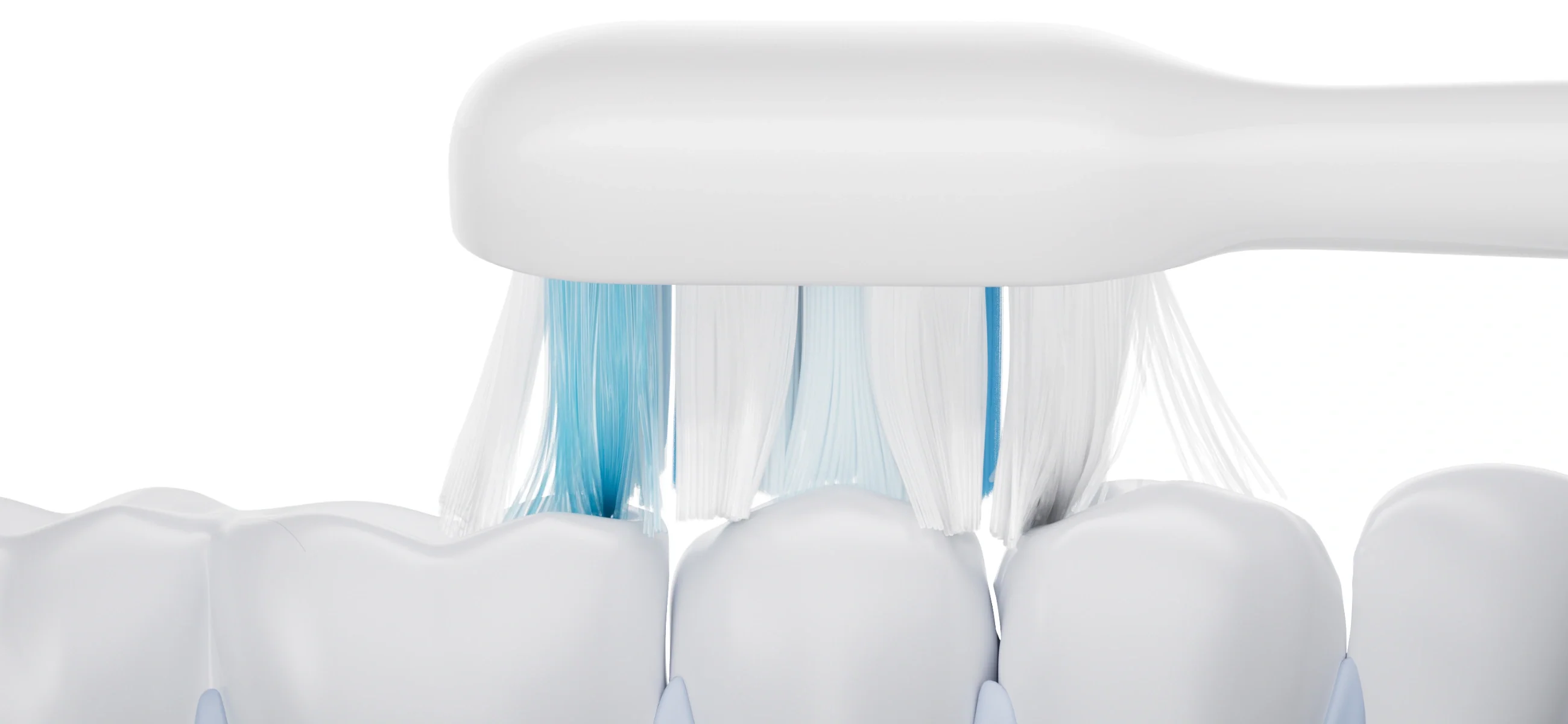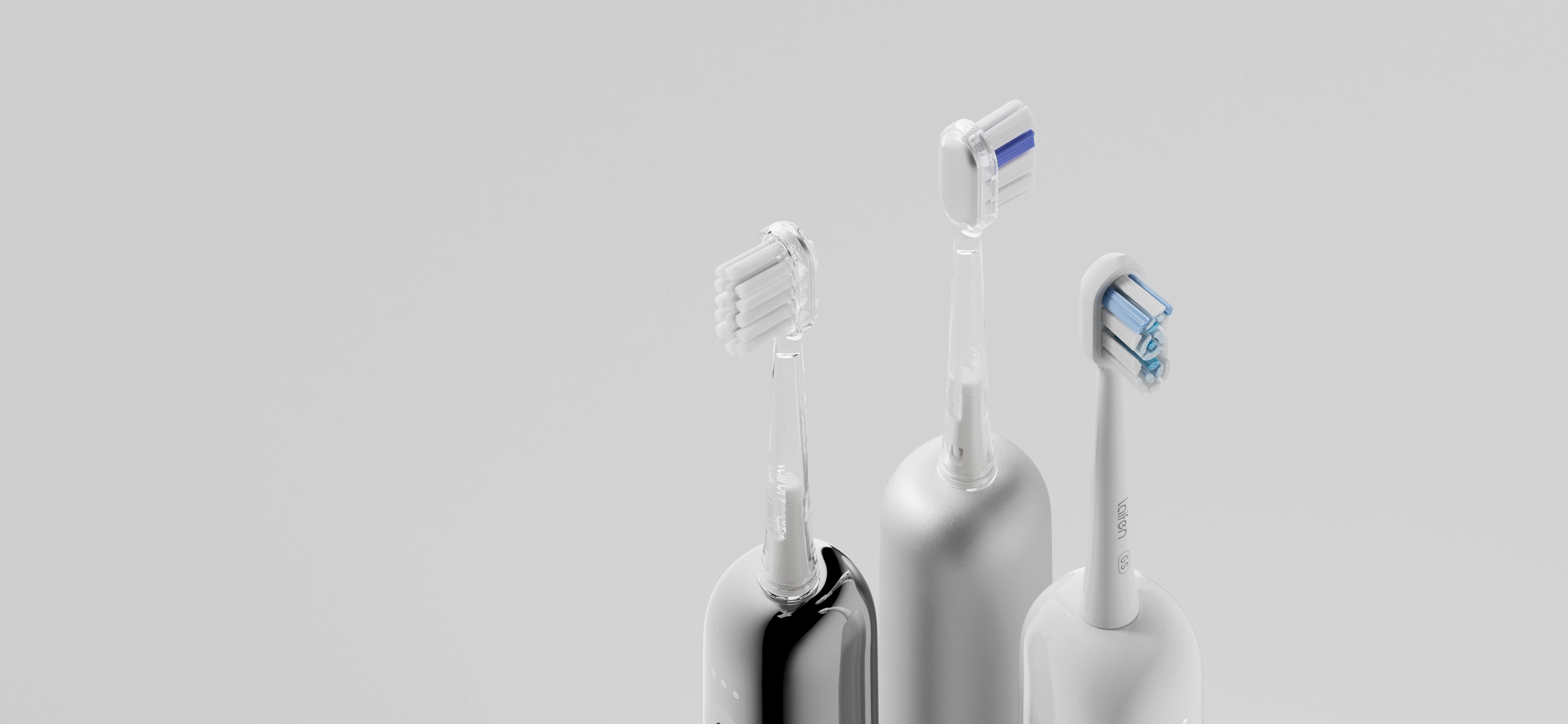It might surprise you, but the connection between a toothache and a headache is remarkably strong. According to recent medical studies, experiencing a toothache increases the likelihood of developing a headache by over 90%. This correlation is supported by numerous dental and neurological experts. For instance, Dr. James Robinson, a renowned dentist and researcher, emphasizes that the nerves in our teeth and head are intricately linked, often leaving the door open to simultaneous pain in both areas.
Understanding why a toothache can cause a headache is deciding for effective treatment and relief. So I’ll uncover the underlying reasons behind this phenomenon and provide you with practical solutions to alleviate both your toothache and headache.
[Related topics: Can a toothache cause ear pain?]
Know about your migraines caused by toothaches
Migraines triggered by dental problems can be particularly challenging to identify and manage. Here, you can briefly review some definitions, types, symptoms, how to differentiate them, and related pain points.
Definitions and types
- Migraine: A neurological condition characterized by severe, often debilitating headaches, usually accompanied by nausea, vomiting, and sensitivity to light and sound.
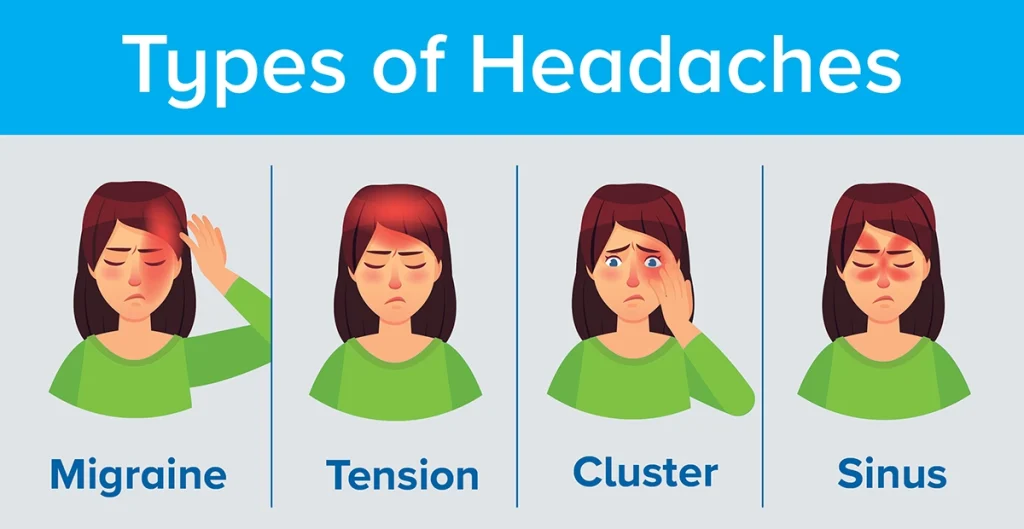
- Toothache-induced migraine: A type of migraine triggered by dental issues such as cavities, infections, or misaligned teeth, resulting in referred pain that manifests as a headache.
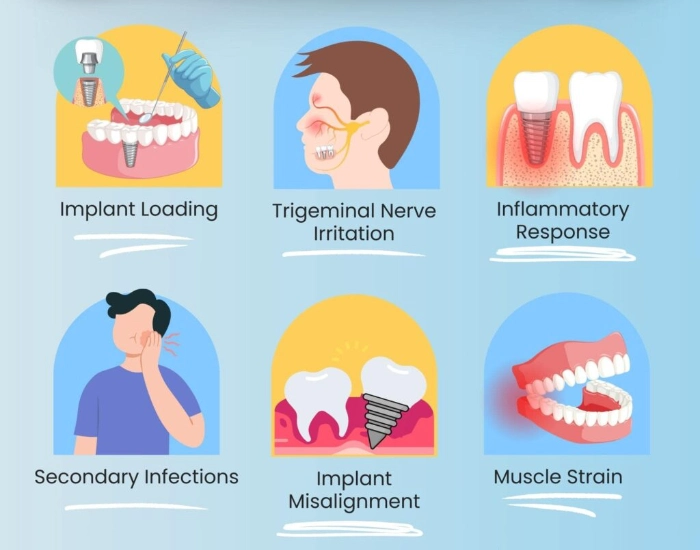
Symptoms
- Migraine symptoms: Intense, throbbing pain, typically on one side of the head, along with nausea, vomiting, and sensitivity to light and sound. Some individuals may experience an aura, which includes visual disturbances or other sensory changes before the headache begins.
- Toothache symptoms: Sharp, throbbing, or constant pain in a specific tooth or the jaw area, which can radiate to the head and contribute to migraine symptoms.
How to differentiate?
- Location of pain: Migraines present as one-sided headaches, whereas toothaches are localized to the mouth and jaw but can cause referred pain in the head.
- Trigger points: Toothache-induced migraines can be triggered by dental issues like chewing or touching a specific tooth, while general migraines may be triggered by factors such as stress, certain foods, or hormonal changes.
Related pain points
- Sinus area: Both toothaches and migraines can cause pain around the sinus area.
- Jaw and neck: Dental issues can lead to tension in the jaw and neck, contributing to migraine pain.
- Temporal area: Pain from a toothache often radiates to the temples, exacerbating migraine symptoms.
Let’s organize those information:
| Toothache-induced migraine | General migraine | |
| Pain location | Starts in the mouth/jaw, radiates to the head | Usually on one side of the head |
| Triggers | Dental issues, chewing, touching specific teeth | Stress, certain foods, hormonal changes |
| Symptoms | Throbbing head pain, sensitivity to light and sound, nausea | Throbbing head pain, sensitivity to light and sound, nausea |
| Additional pain areas | Sinuses, jaw, neck, temples | Often confined to head and neck |
Other related tooth pain to head
Tooth-related head pain is more common than many realize. Beyond migraines, several other types of tooth pain can lead to head discomfort, including:
- Temporomandibular Joint Disorder (TMJ)
- Sinus infections
- Bruxism (Teeth grinding)
- Dental abscess
- Impacted wisdom teeth
- Tooth decay and cavities
Understanding these connections can help in identifying the root cause of the pain and seeking appropriate treatment:
Temporomandibular Joint Disorder (TMJ)
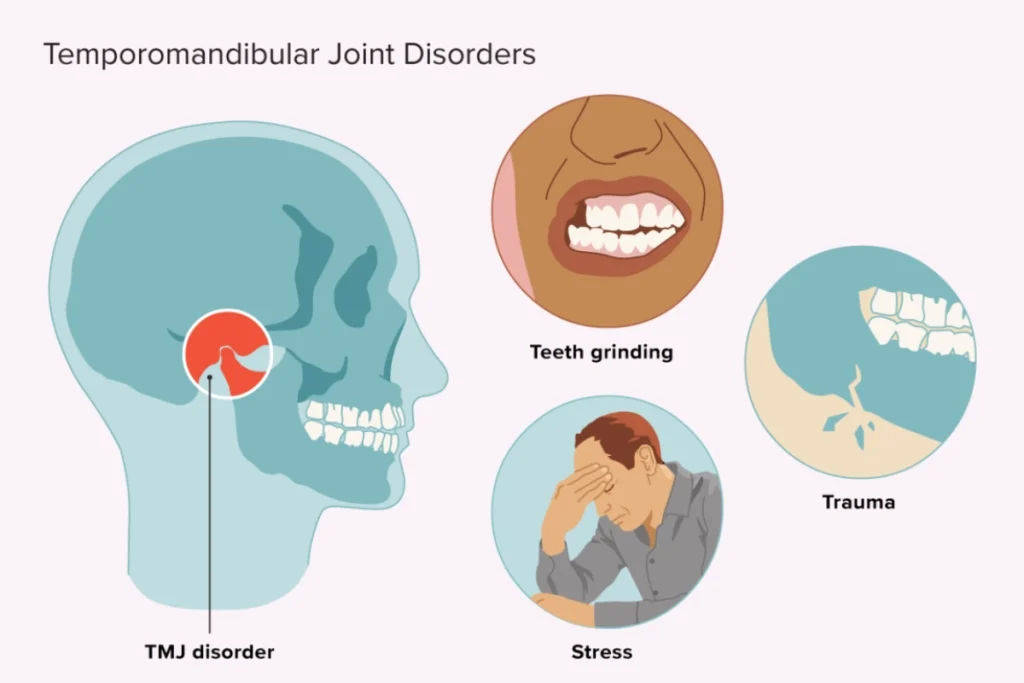
TMJ disorder affects the jaw joint and surrounding muscles. It will cause pain and dysfunction.
Symptoms: Jaw pain, clicking or popping sounds in the jaw, difficulty chewing, headaches.
Notes: TMJ pain often radiates to the temples and can be mistaken for tension headaches. Stress and teeth grinding can exacerbate TMJ symptoms.
Sinus infections
Sinus infections can cause tooth pain, particularly in the upper teeth, due to the proximity of the sinuses to the dental roots.
Symptoms: Facial pressure, nasal congestion, pain in the upper teeth, headaches.
Notes: Sinus-related tooth pain is usually accompanied by other sinus infection symptoms, such as a runny nose and fever. The pain typically worsens when bending over or lying down.
Bruxism (Teeth grinding)
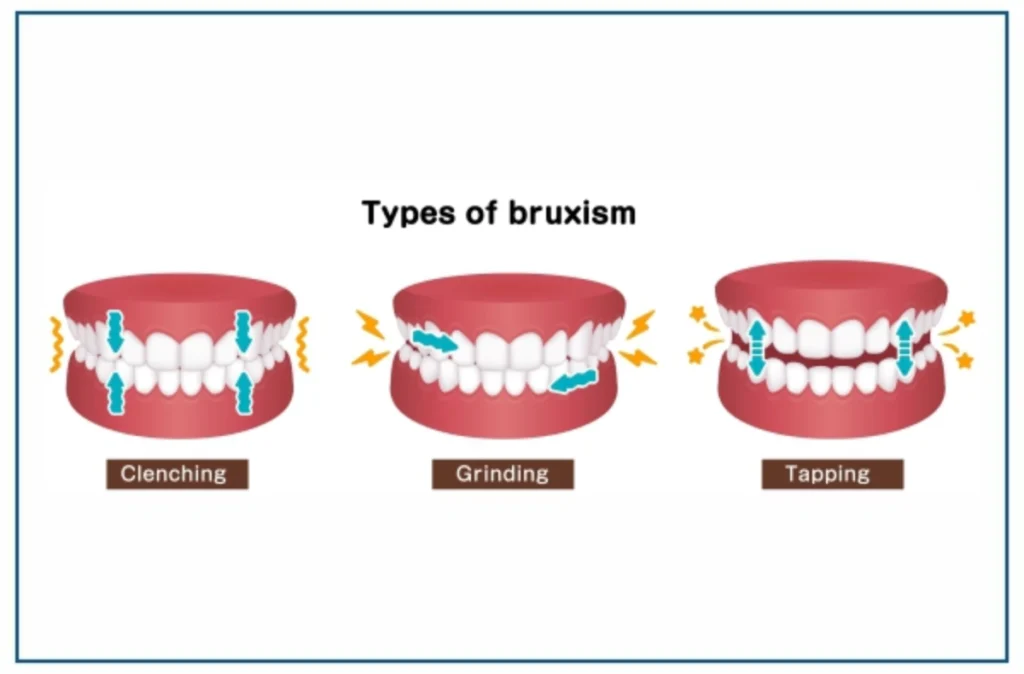
Bruxism is the habit of grinding or clenching teeth, often unconsciously during sleep.
Symptoms: Tooth pain, jaw soreness, worn tooth enamel, headaches.
Notes: Chronic bruxism can lead to temporomandibular joint disorder (TMJ), further contributing to head pain. Stress management and the use of a night guard can help alleviate symptoms.
Dental abscess
A dental abscess is a pocket of pus caused by a bacterial infection in the tooth or gums.
Diagnose: Severe, throbbing toothache, swelling in the face or cheek, fever, headaches.
Notes: The infection can spread to surrounding tissues, causing referred pain in the head. Prompt dental treatment is required to prevent complications.
Impacted wisdom teeth
Impacted wisdom teeth are teeth that have not fully erupted and are trapped beneath the gum line.
Diagnose: Pain and swelling in the back of the mouth, difficulty opening the jaw, headaches.
Notes: The pressure and inflammation caused by impacted wisdom teeth can radiate pain to the head and neck. Surgical removal is often required to alleviate symptoms.
Tooth decay and cavities
Tooth decay occurs when plaque breaks down the tooth enamel, then you will find cavities.
Diagnose: Sharp or throbbing tooth pain, sensitivity to hot and cold, headaches.
Notes: Untreated cavities can lead to infections and abscesses, increasing the risk of referred head pain. Regular dental check-ups and good oral hygiene are crucial for prevention.
Deep reasons cause your toothache and headache
As a seasoned dentist, I’ve seen countless cases where toothaches and headaches are intertwined. Here are some profound reasons why your toothache might be causing a headache:
Nerve pathways
The trigeminal nerve is one of the largest nerves in the head, responsible for sensations in the face and mouth. Dental pain can activate this nerve, leading to referred pain in the head.
Impact: When a toothache stimulates the trigeminal nerve, it can send pain signals to various parts of the head, causing a headache.
Muscle tension
Dental issues like misaligned teeth or bruxism (teeth grinding) can cause muscle strain in the jaw and neck.
Impact: This muscle tension often radiates upwards, resulting in tension headaches. Chronic clenching or grinding can exacerbate this effect, leading to persistent head pain.
Infection and inflammation
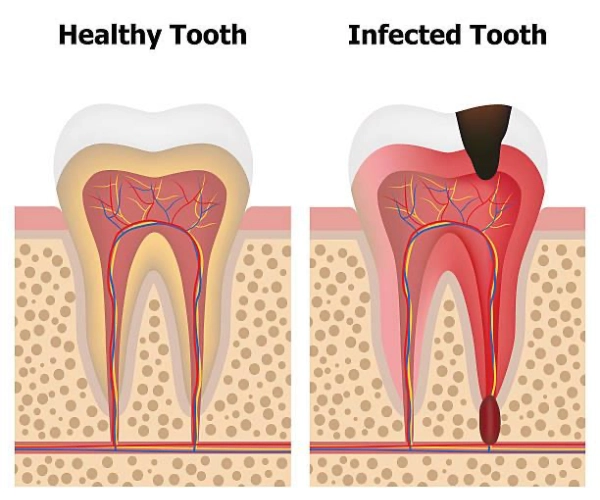
Infections such as abscesses can cause significant inflammation and pressure in the affected area.
Impact: This inflammation can spread to adjacent tissues and nerves, so you will suffer from headaches. The body’s immune response to infection can also cause systemic symptoms, and head pain is not an exception.
Referred pain
Pain in one part of the body can sometimes be perceived in another area, a phenomenon known as referred pain.
Impact: Dental pain, particularly from the molars or wisdom teeth, can be referred to the temples or forehead, presenting as a headache.
Sinus pressure
The roots of the upper teeth are located close to the sinus cavities. Dental problems in these teeth can affect the sinuses.
Impact: Sinus pressure and infection can cause pain that radiates to the head. This is particularly common with upper molar infections or abscesses.
Temporomandibular Joint (TMJ) Disorders
The temporomandibular joint connects the jawbone to the skull. Disorders in this joint will bring in pain and dysfunction.
Influence: TMJ disorders often cause pain that radiates to the head, and what’s different from other reasons is that you may encounter chronic headaches. Misaligned teeth or jaws can exacerbate TMJ issues.
Poor oral posture
Poor oral posture, such as improper alignment of the teeth or jaw, can lead to chronic strain.
Influence: This strain can affect the muscles and nerves connected to the head. Orthodontic issues often play a significant role here.
Dental work complications
Procedures like fillings, root canals, or extractions can sometimes cause residual pain.
Influence: Post-procedure inflammation or nerve irritation can lead to headaches. Proper dental care and follow-up can mitigate these effects.
Best ways to relief from toothache and headache in no time
Want to know how to get relief from toothache and headache? Learn from the following guides.
| Method | Description | How it works | Usage | Effectiveness |
| Over-the-counter pain relievers | Non-prescription pain medications like ibuprofen or acetaminophen | Alleviates inflammation and blocks pain signals in the brain | Ibuprofen: 200-400 mg every 4-6 hours, max 1200 mg/day<br>Acetaminophen: 500-1000 mg every 6 hours, max 3000 mg/day | Starts within 30 minutes to an hour |
| Cold compress | Applying a cold compress to the affected area | Constricts blood vessels, reduces inflammation, numbs pain | Wrap ice packs in a cloth, apply to face/jaw for 15-20 minutes, with breaks | Immediate cooling effect, quick relief |
| Salt water rinse | Cleanses the mouth, reduces inflammation | Salt’s antibacterial properties reduce swelling, kill bacteria | Dissolve 1 tsp of salt in warm water, swish for 30 seconds, repeat several times a day | Provides quick relief, prevents infection |
| Clove oil | Natural analgesic and antibacterial remedy | Eugenol in clove oil acts as a natural anesthetic | Dab clove oil on a cotton ball, apply to tooth/gums; or mix with carrier oil and swish | Quick relief, within minutes |
When dealing with the double whammy of a toothache and a headache, finding quick and effective relief is essential. Here are four methods to help alleviate your discomfort promptly:
1. Over-the-counter pain relievers
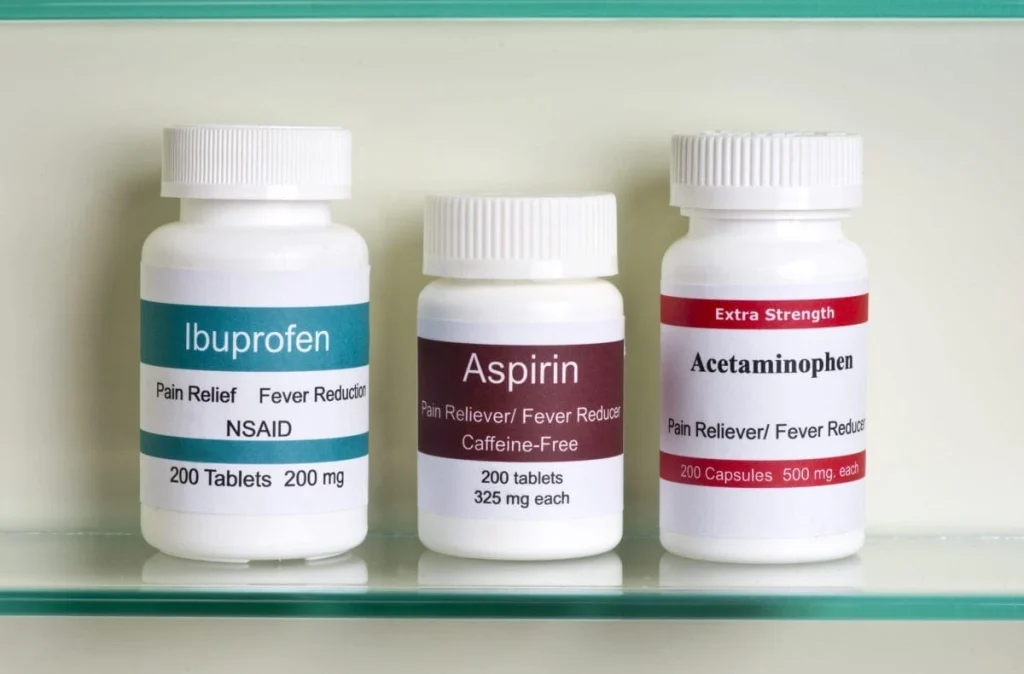
Non-prescription pain medications like ibuprofen (Advil) or acetaminophen (Tylenol) can provide fast relief. These medications reduce inflammation and block pain signals in the brain, addressing both toothache and headache pain.
To use it, follow the dosage instructions on the packaging. Adults can take 200-400 mg of ibuprofen every 4-6 hours, not exceeding 1200 mg per day, or 500-1000 mg of acetaminophen every 6 hours, not exceeding 3000 mg per day.
Effectiveness: Pain relief usually starts within 30 minutes to an hour.
2. Cold compress
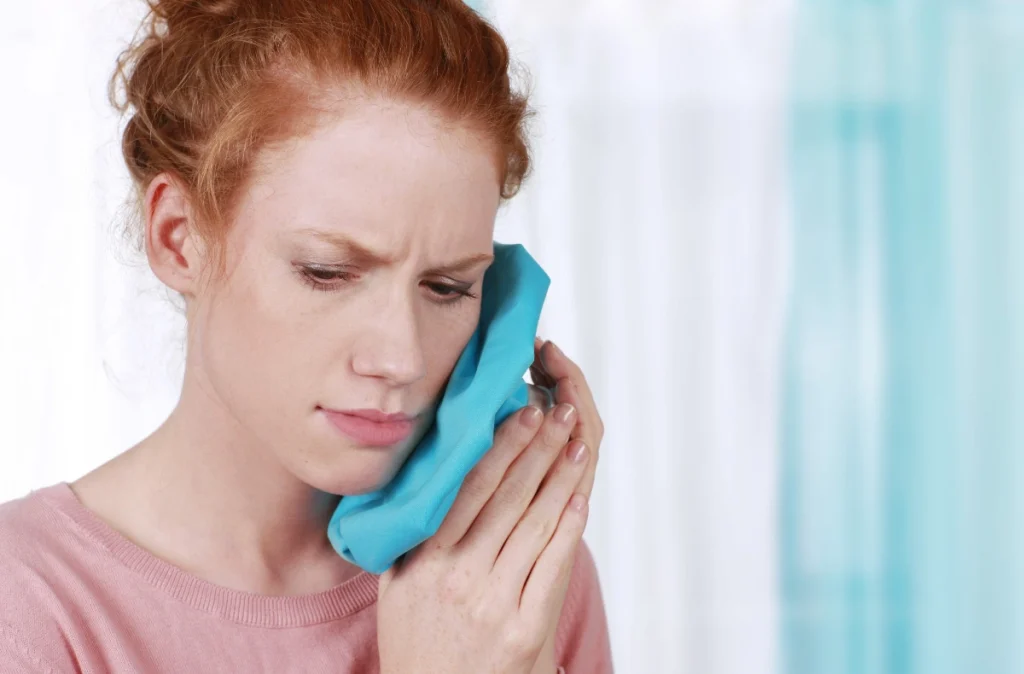
Applying a cold compress to the affected area can reduce swelling and numb pain. The cold constricts blood vessels and provides a numbing effect.
To do it, wrap ice packs or a bag of frozen peas in a thin cloth and apply to the painful area on your face or jaw for 15-20 minutes at a time, with breaks in between.
Effectiveness: Immediate cooling effect can provide quick pain relief.
3. Salt water rinse
A salt water rinse can help cleanse the mouth, recover from inflammation, and alleviate pain. Salt has natural antibacterial properties that can help reduce swelling and kill bacteria in the mouth.
To do it, you can dissolve a teaspoon of salt in a cup of warm water. Swish the solution around in your mouth for 30 seconds, then spit it out. Repeat several times a day as needed.
Effectiveness: Provides quick relief and can prevent further infection.
4. Clove oil
Clove oil is a natural remedy with analgesic and antibacterial properties that can numb toothache pain. Eugenol, a compound in clove oil, acts as a natural anesthetic and reduces inflammation.
To do it, dab a small amount of clove oil onto a cotton ball and apply it directly to the affected tooth or gums. You can also mix a few drops of clove oil with a carrier oil (like olive oil) and swish it around your mouth.
Effectiveness: Provides quick and effective pain relief, typically within a few minutes.
It’s time to find a dentist!
Here are some situations where it’s must to see a dentist:
- If your tooth pain is intense and persistent, it could indicate a serious issue like an abscess or severe infection.
- Any swelling in your face or gums, especially if accompanied by fever, requires immediate dental attention.
- If you have a broken or chipped tooth, it’s important to get it evaluated to prevent further damage or infection.
- Persistent bleeding gums, especially if they bleed easily, can be a sign of gum disease and need professional assessment.
- Adult teeth should not be loose; this can indicate serious gum disease or other dental issues.
- Chronic bad breath can be a sign of infection or other dental problems that need a dentist’s evaluation.
- If you have trouble chewing or swallowing, it may indicate an underlying dental or oral health issue.
- Continuous jaw pain or clicking sounds when opening or closing your mouth can be a sign of TMJ disorder.
- If you experience extreme sensitivity to hot, cold, or sweet foods, it could indicate tooth decay or other issues that need attention.
Best product treatments for toothache and headache
In addition to trying the methods, you can use some products to help you treat headache and toothache.
1. Laifen Wave Oscillation and Vibrating Electric Toothbrush
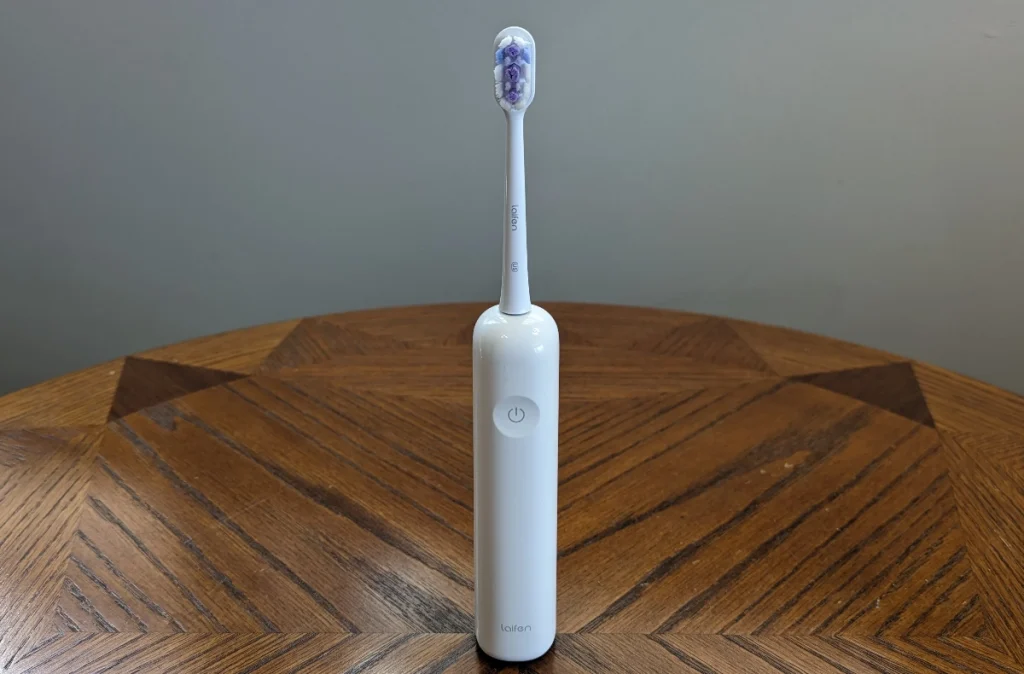
The Laifen Wave electric toothbrush is like a spa day for your teeth, with its advanced oscillation and vibration tech so that users can get a super thorough and gentle clean.
Advantages:
- Combine oscillation and vibration for a deep clean
- 2-minute timer recommended by dentists
- Gum Care replacement head for your sensitive teeth
- Reduce hard plaque and tartar build-up
- Improve gum health
- Multiple brushing modes
- Long battery life
What dentists say: “This toothbrush is the Ferrari of oral care. It keeps your teeth so clean, you might actually start enjoying your dentist visits.”
2. Orajel Severe Toothache & Gum Relief Cream
It is your go-to when you need fast, powerful relief from that unbearable tooth and gum pain.
Advantages:
- Fast-acting pain relief with benzocaine
- Directly targets tooth and gum pain
- Easy application right where it hurts
- Provides numbing relief within minutes
- Portable and convenient for on-the-go relief
What dentists say: “Think of Orajel as a tiny superhero for your mouth – swooping in to save the day when pain strikes unexpectedly.”
3. Excedrin Extra Strength Pain Reliever
This reliever is like having a magic wand for pain. It tackles headaches and toothaches with a powerful combo of ingredients.
Advantages:
- Triple-action formula with acetaminophen, aspirin, and caffeine
- Fast relief for headaches and toothaches
- Reduces pain and inflammation
- Effective for migraines and general pain
- Widely available in most stores
What dentists say: “This is the Swiss Army knife of pain relief. It’s versatile and gets the job done, no matter where the pain hits.”
4. Sensodyne Rapid Relief Toothpaste
This product is the knight in shining armor for sensitive teeth, providing swift relief and long-lasting protection.
Advantages:
- Quick relief for tooth sensitivity
- Strengthens and protects tooth enamel
- Long-lasting protection against pain triggers
- Comfortable on teeth and gums
- Daily use
What dentists say: “Using Sensodyne is like wrapping your teeth in a cozy blanket – it keeps them safe from those pesky sensitivity attacks.”
5. TheraBreath Fresh Breath Oral Rinse
It is your secret weapon for a healthy, fresh mouth, knocking out bacteria and bad breath.
Advantages:
- Kills bacteria that cause bad breath and infections
- Alcohol-free and gentle on your mouth
- Provides long-lasting fresh breath
- Helps reduce plaque and gingivitis
- Perfect for daily use
What dentists say: “TheraBreath is like having a personal bodyguard for your mouth, keeping it fresh and free from harmful bacteria.”
The bottom line
Toothaches and headaches are like those annoying twins that just love to cause trouble together. They’re connected and can be really tough to deal with. If your toothache has been sticking around like an unwanted guest, it’s time to see a dentist ASAP.
But even if your teeth are feeling fine, upping your oral hygiene game is always a good idea. I hope this article helps you get back to a pain-free life and gives you some great tips on keeping those pearly whites in top shape.



